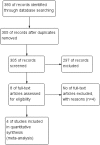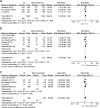Letrozole versus laparoscopic ovarian drilling in clomiphene citrate-resistant women with polycystic ovary syndrome: a systematic review and meta-analysis of randomized controlled trials
- PMID: 30728032
- PMCID: PMC6366034
- DOI: 10.1186/s12958-019-0461-3
Letrozole versus laparoscopic ovarian drilling in clomiphene citrate-resistant women with polycystic ovary syndrome: a systematic review and meta-analysis of randomized controlled trials
Abstract
The objective of this systematic review was to examine the literature and to compare the effectiveness of letrozole (LE) versus laparoscopic ovarian drilling (LOD) for the induction of ovulation in women with clomiphene citrate (CC)-resistant polycystic ovary syndrome (PCOS). The PUBMED, Web of Science, and EMBASE databases were searched systematically for eligible randomized controlled trials (RCTs) from English language articles published from database inception to September 2018. Data were independently extracted and analyzed using the fixed-effects model or random-effects model according to the heterogeneity of the data. Four RCTs including 621 patients (309 in the LE group and 312 in the LOD group) met the inclusion criteria. There were no differences with regard to ovulation rate (relative risk [RR] 1.12; 95% confidence interval [CI] 0.93 to 1.34; P = 0.12, I2 = 90%, 541 patients, three studies), pregnancy rate (RR 1.21; 95% CI 0.95 to 1.53; P = 0.12, I2 = 0%, 621 patients, four studies), live birth rate (RR 1.27; 95% CI 0.96 to 1.68; P = 0.09, I2 = 19%, 541 patients, three studies), and abortion rate (RR 0.7; 95% CI 0.3 to 1.61; P = 0.40, I2 = 0%, 621 patients, four studies) between the two groups. These results indicated that LE and LOD appear to be equally effective in achieving live birth rate in patients with CC-resistant PCOS.
Keywords: Laparoscopic ovarian drilling; Letrozole; Ovulation induction; Polycystic ovary syndrome.
Conflict of interest statement
Ethics approval and consent to participate
Not applicable.
Consent for publication
Not applicable.
Competing interests
The authors declare that they have no competing interests.
Publisher’s Note
Springer Nature remains neutral with regard to jurisdictional claims in published maps and institutional affiliations.
Figures




Similar articles
-
Laparoscopic ovarian drilling for ovulation induction in women with anovulatory polycystic ovary syndrome.Cochrane Database Syst Rev. 2020 Feb 11;2(2):CD001122. doi: 10.1002/14651858.CD001122.pub5. Cochrane Database Syst Rev. 2020. PMID: 32048270 Free PMC article.
-
Letrozole versus clomiphene citrate in polycystic ovary syndrome: a meta-analysis of randomized controlled trials.Arch Gynecol Obstet. 2018 May;297(5):1081-1088. doi: 10.1007/s00404-018-4688-6. Epub 2018 Feb 1. Arch Gynecol Obstet. 2018. PMID: 29392438
-
First-line ovulation induction for polycystic ovary syndrome: an individual participant data meta-analysis.Hum Reprod Update. 2019 Nov 5;25(6):717-732. doi: 10.1093/humupd/dmz029. Hum Reprod Update. 2019. PMID: 31647106
-
Reproductive outcome after letrozole versus laparoscopic ovarian drilling for clomiphene-resistant polycystic ovary syndrome.Int J Gynaecol Obstet. 2011 Jun;113(3):218-21. doi: 10.1016/j.ijgo.2010.11.026. Epub 2011 Apr 1. Int J Gynaecol Obstet. 2011. PMID: 21457973 Clinical Trial.
-
Chinese herbal medicine for subfertile women with polycystic ovarian syndrome.Cochrane Database Syst Rev. 2021 Jun 4;6(6):CD007535. doi: 10.1002/14651858.CD007535.pub4. Cochrane Database Syst Rev. 2021. PMID: 34085287 Free PMC article.
Cited by
-
Competence of Combined Low Dose of Human Chorionic Gonadotropin (HCG) and Clomiphene Citrate (CC) Versus Continued CC during Ovulation Induction in Women with CC-Resistant Polycystic Ovarian Syndrome: A Randomized Controlled Trial.Medicina (Kaunas). 2024 Aug 12;60(8):1300. doi: 10.3390/medicina60081300. Medicina (Kaunas). 2024. PMID: 39202581 Free PMC article. Clinical Trial.
-
Metformin With or Without Clomiphene Citrate Versus Laparoscopic Ovarian Drilling With or Without Clomiphene Citrate to Treat Patients With Clomiphene Citrate-Resistant Polycystic Ovary Syndrome: A Systematic Review and Meta-Analysis.Front Pharmacol. 2022 Jun 22;13:576458. doi: 10.3389/fphar.2022.576458. eCollection 2022. Front Pharmacol. 2022. PMID: 35814214 Free PMC article.
-
Laparoscopic ovarian drilling for ovulation induction in women with anovulatory polycystic ovary syndrome.Cochrane Database Syst Rev. 2020 Feb 11;2(2):CD001122. doi: 10.1002/14651858.CD001122.pub5. Cochrane Database Syst Rev. 2020. PMID: 32048270 Free PMC article.
-
Letrozole for Female Infertility.Front Endocrinol (Lausanne). 2021 Jun 16;12:676133. doi: 10.3389/fendo.2021.676133. eCollection 2021. Front Endocrinol (Lausanne). 2021. PMID: 34220713 Free PMC article. Review.
-
Successful IVF outcome after repeat laparoscopic ovarian drilling in a case of resistant PCOS.BMJ Case Rep. 2020 Sep 9;13(9):e235628. doi: 10.1136/bcr-2020-235628. BMJ Case Rep. 2020. PMID: 32912889 Free PMC article.
References
-
- Fauser BC, Tarlatzis BC, Rebar RW, Legro RS, Balen AH, Lobo R, Carmina E, Chang J, Yildiz BO, Laven JS, Boivin J, Petraglia F, Wijeyeratne CN, Norman RJ, Dunaif A, Franks S, Wild RA, Dumesic D, Barnhart K. Consensus on women's health aspects of polycystic ovary syndrome (PCOS): the Amsterdam ESHRE/ASRM-sponsored 3rd PCOS consensus workshop group. Fertil Steril. 2012;97:28–38.e25. doi: 10.1016/j.fertnstert.2011.09.024. - DOI - PubMed
-
- Dragamestianos C, Messini CI, Antonakis PT, Zacharouli K, Kostopoulou E, Makrigiannakis A, Georgoulias P, Anifandis G, Dafopoulos K, Garas A, Daponte A, Messinis IE. The effect of metformin on the endometrium of women with polycystic ovary syndrome. Gynecol Obstet Investig. 2018;26:1–10. - PubMed
Publication types
MeSH terms
Substances
Grants and funding
LinkOut - more resources
Full Text Sources
Medical
Miscellaneous

